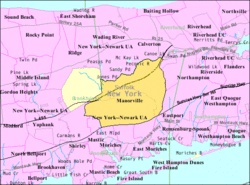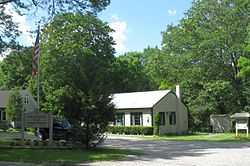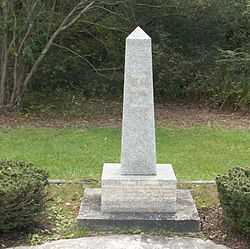Manorville, New York
| Manorville, New York | |
|---|---|
| Hamlet and census-designated place | |
|
| |
 U.S. Census map | |
 Manorville U.S. Census map | |
| Coordinates: 40°50′53″N 72°47′38″W / 40.84806°N 72.79389°WCoordinates: 40°50′53″N 72°47′38″W / 40.84806°N 72.79389°W | |
| Country | United States |
| State | New York |
| County | Suffolk |
| Area | |
| • Total | 25.5 sq mi (66.1 km2) |
| • Land | 25.5 sq mi (66.0 km2) |
| • Water | 0.04 sq mi (0.1 km2) |
| Elevation | 52 ft (16 m) |
| Population (2010) | |
| • Total | 14,314 |
| • Density | 560/sq mi (220/km2) |
| Time zone | Eastern (EST) (UTC-5) |
| • Summer (DST) | EDT (UTC-4) |
| ZIP code | 11949 |
| Area code(s) | 631 |
| FIPS code | 36-45139 |
| GNIS feature ID | 0970329 |

Manorville is a hamlet and census-designated place (CDP) in Suffolk County, New York, United States. The population was 14,314 at the 2010 census.[1]
Manorville is served by the Eastport-South Manor Central School District. Manorville is mostly in the Town of Brookhaven, but its northeast corner is in the Town of Riverhead.
Geography
Manorville is located at 40°50′53″N 72°47′38″W / 40.84806°N 72.79389°W (40.848192, -72.793920).[2]
According to the United States Census Bureau, the CDP has an area of 25.5 square miles (66.1 km2), of which 25.5 square miles (66.0 km2) is land and 0.04 square miles (0.1 km2), or 0.16%, is water.[1]
The hamlet is at the western edge of, and partially within, the Long Island Central Pine Barrens. The land is heavily wooded, and features some wetlands, particularly in the northern section near the Peconic River. Much of the northeastern portion of the hamlet is in the Pine Barrens' "Core Preservation Area", where no further development is allowed. This area also serves as a primary source for Long Island's groundwater preserve.
Manorville is known for its close proximity to the Hamptons, earning the nickname "The Gateway to the Hamptons".
Manorville is in the center of Long Island with no access to the water. It lies partially on the Ronkonkoma terminal moraine, which creates some slightly rolling topography, especially in the central portion of the hamlet. The glacial topography of the area features several kettle hole ponds, the most well-known of which is Punk's Hole,[3] where a Revolutionary War captain was rumored to have hid from the British.
Built in 1975, the 18-foot-high (5.5 m) Shrine of Our Lady of the Island overlooks Moriches Bay.
History
For a hamlet that was until very recently a small farming community, Manorville boasts a long and significant history. The area now known as Manorville once lay within the huge tract of land known as Manor St. George,[3] a land grant given to Col. William "Tangier" Smith in 1693 in recognition of his service as the governor of Tangier in Morocco. The hamlet was given its current name in 1844, when the Long Island Rail Road built a station at Manorville and named it "St. George's Manor". The station agent, Seth Raynor, who was a patriot during the Revolutionary War, disliked the name because it reminded him of the English and the colonial era (St. George, the patron saint of England, is a symbol of the English monarchy). One afternoon, he saw his wife painting the fence at his home. He took the paint can and brush and painted over the sign reading "St. George's Manor", leaving only the word "Manor". Subsequently, it was changed to Manorville by the Post Office Department.
On April 9, 2012, several brush fires joined to ignite over 2,000 acres (810 ha) of woodland around Manorville, Ridge and Brookhaven. By the end of the day, the fires were intense enough to cause a closure of parts of the Long Island Expressway. As of 5:00 PM parts of Riverhead were placed under mandatory evacuation. Brush fires burned 1,124 acres (455 ha) of pine lands. About 600 firefighters from about 109 departments battled the fire with 30 brush trucks, 20 tankers, and 100 engines. Airdrops of water were made by a State Police helicopter.
Demographics of the CDP
As of the census[4] of 2000, there were 11,131 people, 4,122 households, and 2,938 families residing in the CDP. The population density was 438.9 per square mile (169.5/km²). There were 4,243 housing units at an average density of 167.3/sq mi (64.6/km²). The racial makeup of the CDP was 96.38% White, 1.18% African American, 0.12% Native American, 0.66% Asian, 0.04% Pacific Islander, 0.75% from other races, and 0.89% from two or more races. Hispanic or Latino of any race were 4.14% of the population.
There were 4,122 households out of which 36.4% had children under the age of 18 living with them, 63.4% were married couples living together, 5.9% had a female householder with no husband present, and 28.7% were non-families. 24.4% of all households were made up of individuals and 9.6% had someone living alone who was 65 years of age or older. The average household size was 2.69 and the average family size was 3.25.
In the CDP the population was spread out with 27.6% under the age of 18, 5.2% from 18 to 24, 33.1% from 25 to 44, 20.9% from 45 to 64, and 13.2% who were 65 years of age or older. The median age was 37 years. For every 100 females there were 98.4 males. For every 100 females age 18 and over, there were 94.7 males.
The median income for a household was $86,809, and the median income for a family was $106,453 (as of a 2007 estimate[5]). Males had a median income of $52,357 versus $36,382 for females. The per capita income for the CDP was $27,624. About 2.4% of families and 2.8% of the population were below the poverty line, including 2.3% of those under age 18 and 3.2% of those age 65 or over.
Notable people
- Tom Clarke - had a 60-acre (240,000 m2) farm in 1906-07 before returning to Ireland[6]
- Jessica Taylor - was an American prostitute. Was murdered and dumped by her killer in Manorville in 2003.[7]
See also
References
- ↑ 1.0 1.1 "Geographic Identifiers: 2010 Demographic Profile Data (G001): Manorville CDP, New York". U.S. Census Bureau, American Factfinder. Retrieved 2013-01-03.
- ↑ "US Gazetteer files: 2010, 2000, and 1990". United States Census Bureau. 2011-02-12. Retrieved 2011-04-23.
- ↑ 3.0 3.1 Manorville: A Patriot Haven and Cranberry Heaven, Newsday, Retrieved 2009-03-27.
- ↑ "American FactFinder". United States Census Bureau. Retrieved 2008-01-31.
- ↑ U.S. Factfinder
- ↑ The Story of Thomas J. Clarke - aohdivision11.org - Retrieved 2009-10-09
- ↑
| ||||||||||
